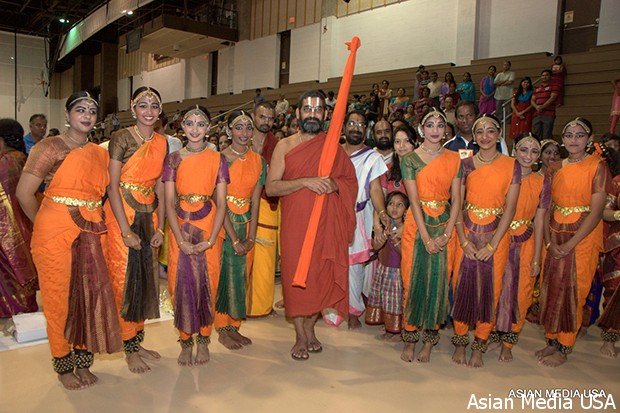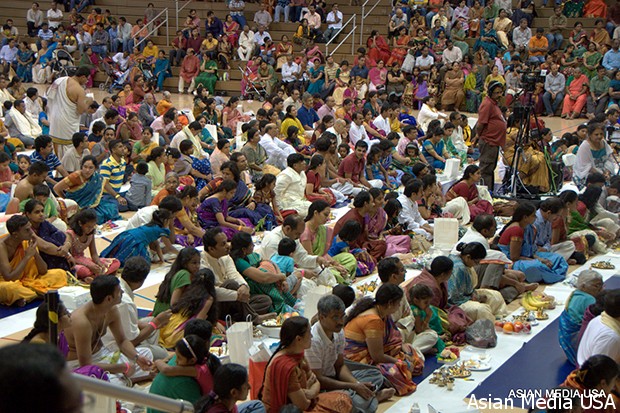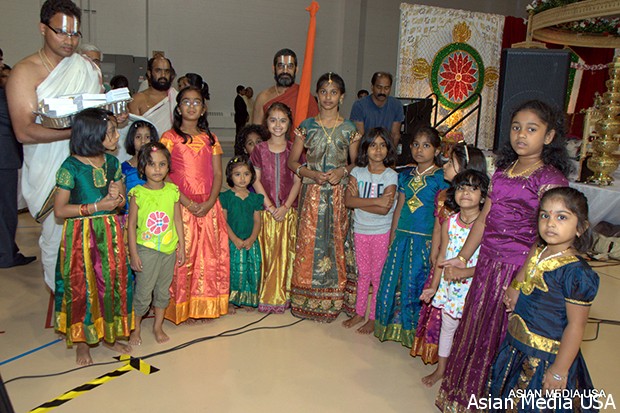HH Chinna Jeeyar Swamiji Conducts Collective Performance of Sita Rama Kalyanam
Chicago IL: The Aurora-based Illinois chapter of the Jeeyar Educational Trust (JET), headquartered in New Jersey, hosted a collective ritual performance of the “auspicious marriage of Lord Rama and his consort Sita” (Sita Rama Kalyanam) conducted by his HH Sri Chinna Jeeyar Swamiji. Preceded by an afternoon program of devotional songs and South Indian classical dances, the unusual event took place on September 7, 2013 at Harper College located in Palatine, Ill. The large number of registered participants seated in orderly rows with the divine images and material for worship neatly arranged before them filled the entire width and length of the gymnasium as many others followed with their eyes and ears from the stepped galleries on both sides.
Chinna Jeeyar Swamiji is a “wandering monk” who belongs to the Vaishnava spiritual lineage of philosopher and reformer Acharya Shree Ramanuja. He walked between the rows distributing images of Rama, Sita, Lakshmana, and Hanuman, before explaining the philosophy underlying Hindu image-worship through a familiar idiom appealing to the American and Christian sensibility that did not hesitate to draw on the Bible. Inspired by his message and example, JET provides humanitarian services including schooling for tribals, fishermen, and the visually challenged, and a hospital, and runs traditional Vedic, Agama and Vedanta schools. All services, education, books, board and lodging and healthcare facilities are provided free of cost to all.
Community leaders present included Raja Krishnamurthi, VHP Chairman, President of American Telugu Association, Kanti Patel, and Vandana Jhingan of TV Asia [who else?] greeted Swamiji and were blessed by HH. Illinois State Rep. Michelle Mussman (D), who has been gracing many an Indian commemoration and sitting through all the cultural performances, sat among the worshippers in the middle of the front row and dutifully performed his ritual instructions. As Swamiji arrived with his retinue more than halfway through the cultural program, he was intercepted by a delegation led by Shalli Kumar, accompanied by Prasad Yalamanchi and others, to present Manju Goel, the Hindu Republican candidate for Illinois District 8, whose campaign was officially launched on Sunday.
The cultural program, which began at 3:00 pm, featured songs and dances that had episodes from the Ramayana for their theme. Minoo Pashupati, who is affiliated to the University of Chicago, presented a chorus of mostly girls led by a white American who played South Indian temple pipe (nadaswaram). Director of Nrityanat Dance Academy (Gurney, Ill.) Poonam Mahesh performed a Bharata Natyam duo with her award-winning student Joshua George to the Tamil composition (keerthanam) “Nee Uraipai Hanumane” set to Ragamalika and Adi thalam (rhythmic cycle). Separated from his dear wife, Lord Rama recalls to Hanuman some of the special moments he had spend with Sita, before dispatching the devoted monk as his emissary to the island of Lanka.
Radhika Ramakrishnan, a student at Vijayalakshmi Shetty’s Chicago-based Nataraj Dance Academy, depicted nine (aesthetic) sentiments (rasa), namely humor, wonder, love, fear, anger, sorrow (instead of the traditional disgust), heroism, (pathos understood here as) compassion, and tranquility through nine select Ramayana episodes in Navarasam, the Tamil lyrics of which were composed by Dandayudhapani Pillai in Ragamalika and Adi Taalam.
Director of Lasyasudha Dance Academy Sudha Kalavagunta had come all the way from Bloomington, Ill., to perform an Annamacharya composition followed by a Sanskrit song from Jayadeva’s Geeta Govindam in Kuchipudi style. She was accompanied by three of her students (including her two daughters) Rosie Socrates, Kirtana Kalavagunta, and Meghana Kalavagunta. Antaraa Anandan, Rekha Iyer, Chandana Kodumuri, Sanchayana Raghuvir, Sree Rajesh, Vedika Ramesh, Abinaya Ramakrishnan, and Shruthi Mohan from Hema Rajagopalan’s Natya Dance Theater performed Govindan Kuzhalosai or “the music of Krishna’s flute” (Tamil) in Ragamalika. The last item before Swamiji’s homely sermon was Jaya Jagadeesha Hare by Shobha Natarajan and her group which described the incarnations of Lord Vishnu.
Swamiji began his preparatory sermon by blessing the performers and devotees. Having praised the precision of Sanskrit among all languages, he explained Vishnu (from root vish-) as God in his all-pervasive aspect and Rama as “beauty” from (ramayati). Love allows us to appropriate that beauty and grow inwardly. He used the familiar example of the mother outwardly matching flowers, dresses, fruits, etc. to “my” baby to illustrate undistracted devotion to Lord Rama. Citing the Bible that “the kingdom of God is within You” to underline that Vishnu dwells within, he recounted the parable of the old lady who lost her sewing needle and kept searching for it under a street lamp on the opposite side of the road. Our required lamp is the scriptures and Guru. He compared the vigraha (deity rather than ‘idol’) to a fan that draws energy (wind) and allows it to be experienced personally here and now.
Food offerings are required because they comes back to us as shared prasadam partaken of joyfully: “joy shared is joy doubled” (and “sorrow shared is halved”). The purpose of puja (worship of the external image) is to initialize this process within oneself. For the body is a mobile temple as opposed to a garbage can or a cemetery. Our sense organs are entrances to the temple, bathing keeps this temple pure, and to dress ourselves is to decorate the image of God within. To perform Sita-Rama-Kalyanam is hence to invoke the “wedding” of Rama’s supremacy and Sita’s compassion within us. He then led the collective performance of the ritual, explaining the minutest details regarding the various items of worship, the gestures (mudra), incantations (mantra), etc., and their meanings.





